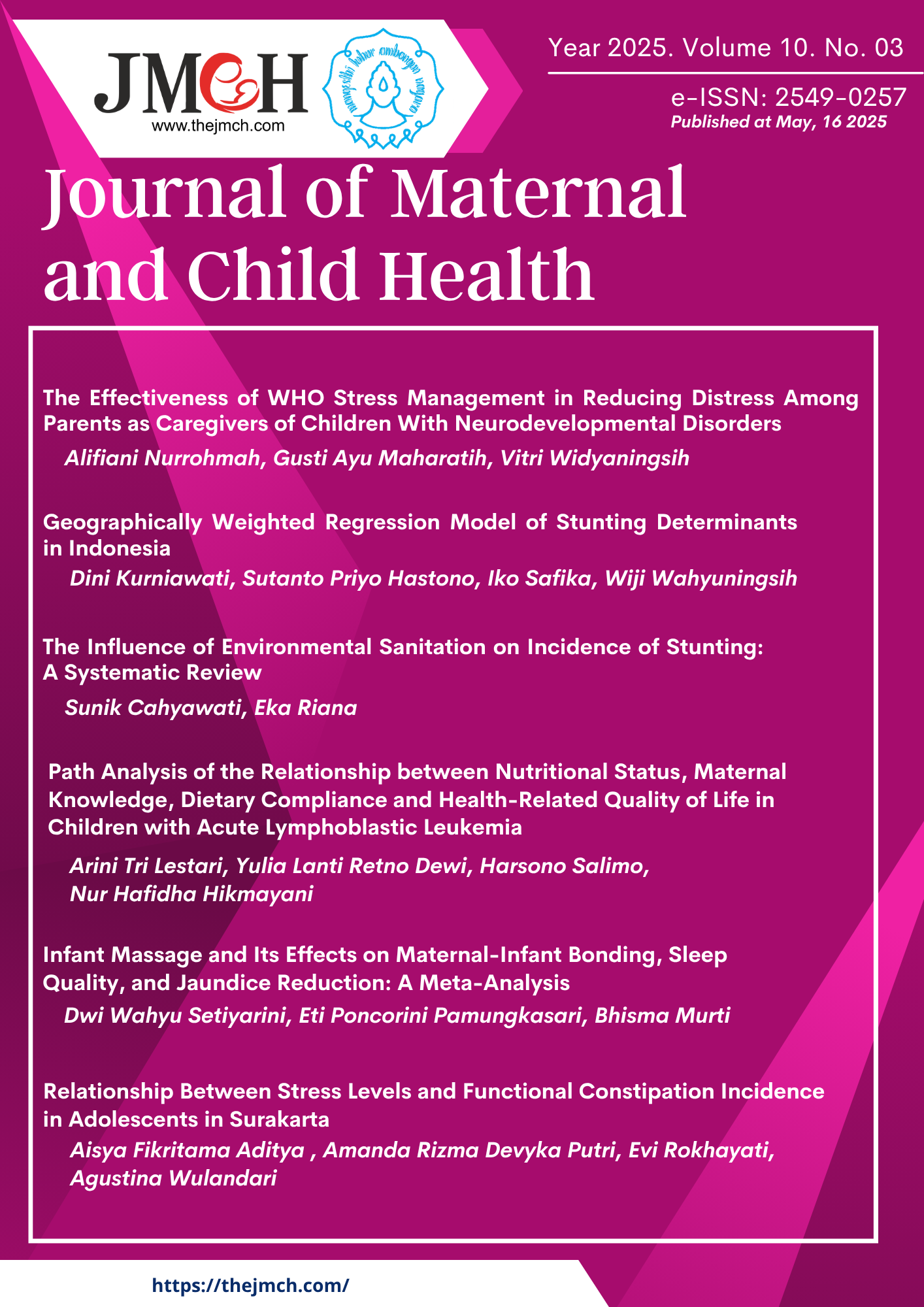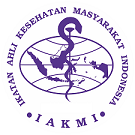Geographically Weighted Regression Model of Stunting Determinants in Indonesia
DOI:
https://doi.org/10.26911/thejmch.2025.10.03.02Abstract
Background: Stunting is a chronic condition resulting from malnutrition during early growth, potentially affecting physical and cognitive development in children into adults. According to the 2023 Indonesian Health Survey (SKI), stunting in Indonesia remains at 21.5%. This figure is still far from the government's target for 2024, which was below 14%. This study aims to identify the determinants of stunting caused by spatial conditions in Indonesia in 2024.
Subjects and Method: This study employed an ecological design with a spatial approach, utilizing aggregate data from the 2023 SKI and 2024 Central Bureau of Statistics (BPS) across 38 provinces in Indonesia. The dependent variable was stunting prevalence, and the analysis included eight independent variables using descriptive statistics, spatial analysis (Moran’s I and Local Moran’s I), multiple linear regression (OLS), and Geographically Weighted Regression (GWR). Data was processed between November 2024 and January 2025 using SPSS, Geoda, and R Studio.
Results: Results show that the average stunting prevalence in Indonesia in 2024 was 23.56% (Standard Deviation: 6.80), which unmet the government’s target in the same year. The provinces with the lowest and highest stunting prevalence were Bali (7.2%) and Central Papua (39.3%). Meanwhile, Papua, West Papua, South Papua, Central Papua, and Highlands Papua were provinces with high stunting prevalence and surrounded by similarly high prevalence (high-high) provinces. In contrast, Banten and West Sumatra had high stunting prevalence but were surrounded by provinces with low prevalence (High-Low). Finally, factors influencing stunting across geographical areas included stunting knowledge, completion of immunization coverage, and poverty rates.
Conclusion: Efforts to reduce stunting in Indonesia should focus on improving communication, information, and education, particularly in provinces with high prevalence. In addition, increasing coverage and access to complete basic immunization and enhanced family welfare should also be highlighted.
Keywords:
stunting, geographically weighted regression, spatialHow to Cite
References
Akolo IR (2022). Perbandingan matriks pembobot Rook dan Queen contiguity dalam analisis Spatial Autoregressive Model (SAR) dan Spatial Error Model (SEM). Jambura Journal of Probability and Statistics. 3(1): 11–18. https://doi.org/10.34312/jjps.v3i1.13582
ASEAN Stats (2022). The 2022 ASEAN Snapshot Report. https://www.aseanstats.org/wp-content/uploads/2022/11/The-2022-ASEAN-SDG-Snapshot-Report
BKPK (2023). Survei Kesehatan Indonesia (Indonesian Health Survey).
BPD Provinsi Banten. (2022). Dampak COVID-19 terhadap stunting. https://penghubung.bantenprov.go.id/Artikel/topic/1043
Gerstman BB (2013). Epidemiology kept simple: An introduction to traditional and modern epidemiology (3rd ed.). John Wiley & Sons, Inc.
Grekousis G (2020). Spatial analysis methods and practice. Cambridge University Press. https://doi.org/10.1017/9781108614528
Juniantari NPM, Triana KY, Sukmandari NMA, Purwaningsih NM (2024). Hubungan pengetahuan ibu terhadap kejadian stunting pada balita di Wilayah Kerja Puskesmas Abang I (The relationship between maternal knowledge and the incidence of stunting in toddlers in the Abang I Health Center Work Area). Jurnal Keperawatan. 12(1): 58–69.
Karyati Y (2021). Pengaruh jumlah penduduk miskin, laju pertumbuhan ekonomi, dan tingkat pendidikan terhadap jumlah stunting di 10 Wilayah Tertinggi Indonesia Tahun 2010-2019 (The influence of the number of poor people, economic growth rate, and education level on the number of stunting in the 10 Highest Regions of Indonesia in 2010-2019. Jurnal Riset Ilmu Ekonomi Dan Bisnis: 101–108.
Kurniawati E (2020). Faktor risiko kejadian stunting pada balita di kabupaten Kerinci provinsi Jambi (Risk factors for stunting in toddlers in Kerinci district, Jambi province). Journal of Health Science and Physiotherapy. 2(2): 143–151.
Ningtyas YP, Udiyono A, Kusariana N (2020). Pengetahuan ibu berhubungan dengan stunting pada balita di Wilayah Kerja Puskesmas Karangayu Kota Semarang (Mother's knowledge related to stunting in toddlers in the Karangayu Health Center Work Area, Semarang City) Jurnal Kesehatan Masyarakat. 8(1): 1–7.
Pramono MS, Wulansari S, Sutikno S (2012). Pemetaan determinan angka kematian bayi di Jawa Timur berdasarkan indikator indeks pembangunan kesehatan Masyarakat (Mapping of determinants of infant mortality rates in East Java based on community health development index indicators). Buletin Penelitian Sistem Kesehatan. 15(1): 213–225.
Ramadhani FN, Kandarina BI, Gunawan IMA (2019). Pola asuh dan pola makan sebagai faktor risiko stunting balita usia 6-24 bulan suku Papua dan non Papua (Parenting and eating patterns as risk factors for stunting in toddlers aged 6-24 months in Papuans and non-Papuans). Berita Kedokteran Masyarakat. 35(5): 175–183.
Resfaliza, Kamarni N, Purwasutrisno (2024). Kausalitas antara variabel makro dan stunting di Sumatera Barat periode 2021-2023 (Causality between macro variables and stunting in West Sumatra for the period 2021-2023). Jurnal Informatika Ekonomi Bisnis. 6(3).
Sipahutar T, Eryando T, Budiharsana M (2022). Spatial analysis of seven islands in Indonesia to determine stunting hotspots. Kesmas: Jurnal Kesehatan Masyarakat Nasional. 17(3): 228. https://doi.org/10.21109/kesmas.v17i3.6201
Soliman A, De Sanctis V, Alaaraj N, Ahmed S, Alyafei F, Hamed N, Soliman N (2021). Early and longterm consequences of nutritional stunting: From childhood to adulthood. Acta Bio Medica: Atenei Parmensis. 92(1). https://doi.org/https://doi.org/10.23750/abm.v92i1.11346
Sutarto S, Mayasari D, Indriyani R (2018). Stunting, faktor resiko dan pencegahannya (Stunting, risk factors and prevention). Jurnal Agromedicine. 5(1): 540–545.
Tahangnacca M, Muntahaya F (2023). Spatial pattern of stunting on children under five in Indonesia 2019. Jurnal Kesehatan Reproduksi. 13(1): 47–55. https://doi.org/10.58185/jkr.v13i1.36
Wanda YD, Elba F, Didah D, Susanti AI, Rinawan FR (2021). Riwayat status imunisasi dasar berhubungan dengan kejadian balita stunting. Jurnal Kebidanan Malahayati. 7(4): 851–856. https://doi.org/10.33024/jkm.v7i4.4727
Yadika ADN, Berawi KN, Nasution SH (2019). Pengaruh stunting terhadap perkembangan kognitif dan prestasi belajar (The effect of stunting on cognitive development and learning achievement). Jurnal Majority. 8(2): 273–282.











